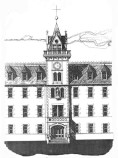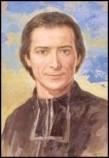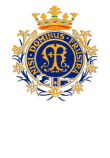School History
The Story of St Joseph's College
St. Joseph’s College was founded as a boarding school for boys in 1875, by the Marist Brothers, a Roman Catholic Teaching Order, which originated in France. Under the
direction of the first Principal, Brother Alphonsus, the school opened with twelve pupils.
The College was originally housed in what had been the Dumfries Infirmary, opened in 1778, in the Dock Park, where the modern flats now stand in Grant Court. It was purchased on behalf of the Marist
Brothers in 1874 by a Mr. Murphy of Dumfries, after the Infirmary moved to its new quarters, across the road at Nithbank. It was to be used for the training of young men for the Marist Brotherhood,
and owing to the demand for boarding school education they accepted the first boarders on 5th January, 1875.
The accommodation was soon found to be too small for the demands which were made on it, and so the Brothers purchased the property known as Laurel Mount on the Craigs Road in 1877, built a new
training school for young Brothers and renamed it Mount St. Michael. St. Joseph’s College continued in the old Infirmary until further need for expansion caused the Brothers to build the present main
building in 1909.
In the 1920s the extensive playing fields at Maryfield were purchased, and in 1925 the College Chapel was dedicated to the memory of those former pupils who had died in the First World War. The old
gymnasium known as the Brother John Joseph Memorial Hall, was opened in 1934, and in 1960, the Assembly Hall block was opened.
In 1971, the Marist Brothers and the Dumfriesshire Education Authority made an arrangement whereby all Roman Catholic boys of secondary school age living in Dumfriesshire, could attend the College,
and by 1975, the Centenary Year, the role had risen to almost 600. Around that time, further negotiations were initiated between the Marist Brothers and Dumfries and Galloway Regional Council, with a
view to the College becoming a Roman Catholic Comprehensive School for girls and boys. Thereafter a policy of phasing out the boarding population began.
In 1981, the College was taken over formally by Dumfries and Galloway Regional Council, to become one of the four six year co-educational comprehensive schools within the Burgh of Dumfries. It was to
have a special regard for the educational needs of the Roman Catholic population, from the catchment areas of Dumfries, Annan, Castle Douglas and Dalbeattie, but places at St. Joseph’s College are
also available to children of secondary school age of other denominations whose parents wish to send them to the College. This is very much in keeping with the tradition established by the Marist
Brothers.
The Regional Authority drew up a major rebuilding programme, which involved expenditure of a sum in excess of £4 million over the years l982 - 1987. Once this was underway, the first lay Headmaster
commenced in 1982 after which girls were accommodated from the Benedictine Convent School and St. Andrews Secondary School.
Many of its past pupils have made significant contributions to the Church, the professions and to public life in general, which has enhanced the name of the College within the British Isles and
beyond. These are traditions which all staff, parents and pupils should strive to maintain and develop within the framework of the changed circumstances.
St Marcellin Champagnat, the Founder of the Marist Brothers, was born in the district of Marlhes, France, in 1789. He died fifty-one years
later, in 1840, at a place called Our Lady of the Hermitage in the valley of the Gier River, only about 30 kilometres from Marlhes. His whole life was spent in this small region. By studying his
spirit we can learn much about the traditions and spirit of St. Joseph's College
His life was simple and unspectacular. The region in which he lived and worked was run-down, materially poor, educationally ignorant, and morally at a low ebb, for the French Revolution and
Napoleonic Wars had taken toll of such districts in France. Some civic and church authorities as well as fellow priests, bitterly opposed Fr. Champagnat's attempts to found an Order of Brothers who
could help alleviate this misery both locally and overseas. They said he was mad, incapable of such a work, lacking in sufficient brains and destitute of sufficient resources.
But when he died in 1840, more than 320 young men had already chosen to follow his way of life and work. Within twenty years this number expanded to well over 2000, so that today there are some 6000
Brothers teaching over 500,000 students throughout the world. Over the years the spirit of St Marcellin Champagnat has been handed on to the Brothers and to the teachers and students of their
schools.
This has been especially true for the total boarding community which St. Joseph's has been until recently. What are the characteristics of this spirit, and how do they apply to us? Here are some of
the main elements:
1. Simplicity - Champagnat was of strong rural stock, an uncomplicated person who made no fuss, worked hard, ate sparingly, went by foot most of the time, found schoolwork difficult as a boy, and as
a priest had a great love for the little people of his world. With his spirit we have no need to boast, no matter what our talents or achievements are.
2. Deep Concern Champagnat was a man of great compassion - for youth, the rural poor, delinquents, orphans, the sick, the elderly, the dying and disadvantaged. We too can have this great compassion
for those around us - in our Year group, classroom or dormitory.
3. Open-mindedness Similarly we can be people of great compassion towards the disadvantaged of our society -whether it be through colour, race, poverty, addictions, handicap or illness.
4. Trust in God and Mary his Mother Marcellin had an habitual trust in God as Father and in Mary as the "good Mother". This confidence in God and Mary can be a characteristic in all we do, helping to
remove fear when we meet crises (examinations, misunderstandings, times of trouble) and giving us calm in times of failure or loss.
5. Strength of Character Champagnat never gave up, despite immense opposition on all sides, even from those he trusted, despite many disappointments and increasing ill-health. We too can imbibe this
spirit - we can fight on, stick at what we do, and not lie down. For example, we can study harder or train better. If we make mistakes or are in trouble, we can get over it, not give up, bear no
grudge and strive on.
6. Family Spirit Marcellin specialized in achieving warmth of relationship in his communities. Young men were attracted by his warmth and the happiness of his Brothers. The community of the Marist
school can also specialise in being 'family' - an accepting place where all students, teachers, parents and helpers work together for the common good
7. Practical Wisdom Champagnat had a strong practical sense. He understood his times and he adapted his schools to the changes that were happening - unlike so many other churchmen of his time who
worked to restore the "old ways" and thus caused much bitter anti-clerical feeling as the century proceeded. We too can be people of good, sound, practical sense, shunning falseness, developing
upright ways, working hard, not making excuses, being totally open, frank and prompt.
In summary, we will fit easily into the traditions of the College if we work hard, think of others, show common sense, be helpful, develop a trust in God and a devotion to Mary, avoid boasting and
never give up.
(written by James Gray)
The College Crest is gold on a royal blue background. Not unnaturally it symbolises the Marist foundation of the College. The ‘M’ in the centre
represents Mary, the Mother of Jesus, and the Crown is her crown as Queen of Heaven. The whole crest represents the Marist Brother’s devotion to Mary, and indicates the origin of their name, as the
‘Little Brothers of Mary’.
The College Motto ‘ Nisi Dominus Frustra ’ comes from the second verse of the 126th psalm, where David says “Unless the Lord guard the city, the guards watch in vain”. In Latin this reads “Nisi
Dominus custodiunt cogitate frustra vigilant qui custodiunt eam”. The three key words taken together mean” Without the Lord all is in vain”. This motto is shared with Edinburgh, the capital city, and
with the King’s Own Scottish Borderers Regiment.









